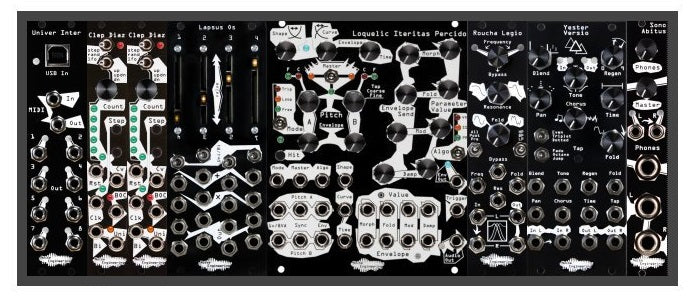Getting started: some of our favorite small cases
Building your first Eurorack system can be a big challenge, and picking out the first few modules to put into a case is a tough decision. There are many different approaches to Eurorack, and many goals that can be achieved, so today we decided to put together a few different cases, each with different patching styles and end results. Each one has a ModularGrid link so you can take a look and customize it to your own liking.
We’ll chat a bit about why we chose the modules we did and how they can be patched together. We hope this will aid you on your way to putting together your own system, or inspire you in ways to use an existing one!
By the way, if you’re still learning about what different modular functions do, the rest of our Getting Started series is a great primer on the different building blocks of synthesizers and Eurorack in general.
System 1: Markus’s MIDI-motivated modulation mayhem

Lapsus Os can act as attenuators for any modulation signals, like random or stepped modulation from the two Clep Diaz, or simply act as DC offset generators to control the voice or effects.
Speaking of the voice, we have the Loquelic Iteritas Percido, an all-in-one voice that generates sound with a complex oscillator. It has a VCA and envelope generator built in, which allows us to skip some utilities. To change the timbre of the Loquelic further, Roucha Legio is a multimode filter with loads of character, and Yester Versio is a clockable delay that creates atmosphere and stereo width.
On the completely utilitarian end of things, Sono Abitus is a headphone and balanced line output module, useful for connecting to an audio interface or other gear (or just jamming with a pair of headphones).
System 2: Kris’s percussion groovebox

This system takes a different approach: no external gear or sequencing needed, it’s all in the rack already!
On the sequencing side of things, Horologic Solum generates clock signals at selectable divisions, perfect for driving our two sequencers at different rates, or creating simple rhythms. For more variable rhythm sequencing, Zularic Repetitor, an algorithmic rhythm generator, has enough outputs to drive the voices in our system (and for creative applications like gate modulation). Mimetic Digitalis is an X/Y CV sequencer that’s perfect for creating dynamic percussion modulation, and it can also be used to sequence melodies in the rack if you’re not feeling as percussive.
On the synthesis side of things, Basimilus Iteritas Alia and Tymp Legio are two complementary percussion voices that can create any percussive sounds you might need. Xer Dualis can then be used to combine the voices in the system, and add a performative edge to the patch with its mutes and level controls.
Rolucha Legio is a familiar face, and can be placed directly after one of the voices to shape its timbre, or after the mixer to create dramatic DJ-style swells. Finally, a clocked delay is a fun way to fill space in a percussion patch, so Yester makes a return, too.
System 3: Shawn’s rhythmic processor

Here’s an entirely different approach to a synthesis task. This case can’t generate sound on its own!
Shawn put this system together with the goal of creating rhythmic patches out of drones and voice samples from musical toys and gadgets he had around his studio. Nive Grad adjusts levels up or down as necessary, and they’re then fed into the four Sinc Bucina lowpass gates. Xer Dualis combines the four sounds and then feeds them into Desmodus Versio for some reverb.
To create rhythmic patterns, Horologic Solum drives Zularic and Numeric Repetitor, generating 8 rhythmic patterns to choose from. Fractio Solum is a clock divider/multiplier that can be used to generate polyrhythmic triggers, or drive one of the Repetitors at a completely different rate from the other.
System 4: Patrick’s 6U performance case

Sometimes one row just isn’t enough. Patrick put this performance-oriented case together for some jams he was doing, and it features a high density of voices and effects with some utilitarian sequencing options.
This system has four voices. Basimilus and Debel Iteritas Alia are full percussive/melodic voices on their own, and Loquelic Iteritas and Virt Iter Legio are free-running oscillators that require something to control their levels. Quantus Ampla and Pons Asinorum are quad VCAs and envelope generators respectively, and have extra channels left over for more modulation duties elsewhere in the patch.
The only dedicated trigger sequencer is Bin Seq, but with clock divisions from Horologic Solum and some trigger modification from Jam Jam it’s possible to create some funky rhythmic patterns.
Patrick says the Mimetic & Vox Digitalis combo is perfect for generating pitch CV for bass and lead lines, with extra randomized CV for modulating other parts of the patch. Each voice’s trigger input can be muted with Muta Jovis, making it easy to bring in and out of the patch. After mixing all the voices in Xer Dualis, Librae Legio adds some compression and glue to bring everything together.
Platform Perks
Each of these systems includes at least one of the Noise Engineering platform modules (Legio, Alia, and Versio). These modules are fun because they all have multiple firmware options. Tired of one voice on the Alia? Swap it out for free at the Noise Engineering Customer Portal. Legio has a variety of effects and oscillators; Versio has nine different effects options. A platform module is a great way to add dexterity to a small case.
You can’t go wrong
We hope these different system concepts gave you some ideas for putting your own system together. Starting with something that sounds inspiring to you, whether that’s an oscillator, an effects processor, or perhaps a sequencer is a great way to dip your toes in – then you can fill in the blanks as you find new utilities you’d like to add in. You’ll be jamming in no time!





